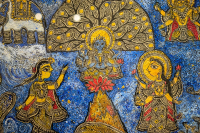Culture & Lifestyle
Pond restoration is not only reviving Thimi’s water heritage but also its groundwater reserves
The local government's initiative to restore drying ponds is not only reviving the ancient town's water system but also its groundwater services.
Shashwat Pant
When the restoration work initially started at the Dui Pokhari in Thimi, in 2018, many were sceptical. Locals were not convinced that the user committee formed to restore the pond would actually have anything to show for work.
“Many previous attempts to restore the pond had failed. This was because most of the time, people who lacked skill and expertise were hired and they couldn't complete the project,” says Prakash Sthapit, a resident of Thimi.
But to Sthapit's surprise, the restoration work this time around was completed in a span of just two years. “I had no hope that they would do it, but I am glad they did. The place feels like it was back when I was growing up again,” says 73-year-old Sthapit.
The completion of the project wasn’t the only thing that was surprising though, he says. A few months after the pond was restored to its old glory, the wells in the vicinity that had dried up had started to fill up with water. Other sources of groundwater also started to rise.
“The sources had dried up decades ago, but they amazingly reappeared. The groundwater in the area had depleted severely for years, but after the pond was rebuilt, it also started rising,” says Sthaphit. “People had been queuing for hours to get their vessels filled with water at communal taps, but that problem has stopped—to an extent. It’s like the gods are happy with us once again.
Many of the Valley’s ponds have been lying in a dilapidated state for years. A lot of ponds in the Valley have disappeared, especially in Kathmandu where there have been few efforts to restore ponds. The neglect towards the water system started from the Panchayat era, says Padma Sundar Joshi, program director at UN-Habitat. And while there have been efforts to revive ponds in some parts of Lalitpur, it has been Bhaktapur that has been leading the way to restore dead ponds.
“Ponds started disappearing after the destruction of rajklulos (state canals),” says Joshi. Rajkulos were equivalent to today’s modern water transmission pipes. They replenished the ponds, and were the most important and ingenious design in the Valley’s water supply system, says Joshi. But as haphazard urbanisation took off, those canals started being disrupted and then they disappeared altogether. This resulted in these centuries-old ponds drying out.

Joshi says the various governments that took power since Nepal became a multi-party democracy also did not help protect and preserve the Valley’s rich water heritage. “The government seems least bothered to protect our country’s water heritage. It is evident in the way they have permitted buildings to be built over spaces where there were once ponds and stone sprouts,” says Joshi.
But in Bhaktapur, pond restoration has been the local government’s priority for a while now, ever since Siddha Pokhari was revived in 1999. “Siddha Pokhari was as good as dead. It was swampy like a quicksand. What people see now is something remarkably different. The revival of the pond gave people hope that ponds could be revived,” says Madan Sundar Shrestha, Mayor of Thimi. The pond today is a major source of tourist attraction for Bhaktapur’s Visit Nepal 2020 campaign as well.
Of course, restoring ponds do not come cheap. But how much budget is allocated to the restoration work depends on the local government’s priorities, says Shrestha, whose government has included pond restoration as a major part of their manifesto. “We spent Rs 15 million to restore the Dui Pokhari [which means two ponds] in Thimi. I was told other governments only spend Rs 200,000. You can’t restore ponds at such a low cost,” says Shrestha.
He adds that they started the project to restore the pond because the town started to face a drinking water shortage. “Initially people were having problems drawing water, after which wells started to dry up. That was enough motivation for us to start restoring ponds. When you start facing problems like these, as the local representative, you have to do something,” says Madan Sundar Shrestha. After the Dui Pokhari was restored, the water levels rose in around 20 wells in the area, says Shrestha.
The process to restore ponds, according to Niranjan Shrestha, president of the Nu Pukhu Reconstruction User Committee, is simple. The first thing he says the committee did was clear the pond of the shrubs that had grown. After the clearing was done, the committee sought the assistance of experts on the process to restore the ponds.
“After consultation with various experts, we decided that the pond would need two layers of kalo mato (black clay), a layer of pango mato (clay) and a layer of bricks. Doing that we were told the process would be enough to hold water in the pond and ensure seepage,” says Niranjan.
The committee then dug the pond, laid six inches of kalo mato after which they laid three inches of pango mato followed by another six inches of kalo mato. After that was done, four inches of bricks were laid on top. “We decided to stick with the traditional method of restoration,” says mayor Shrestha.
They then added water by boring it, but as monsoon will arrive, the natural system of storage and seepage will start, he says. The same process will be used to restore another pond in Bode, where works have already started.
Such community work has also given rise to local participation. Children, as well as older people, have come together and there’s an apparent awareness among people regarding water recharge systems. But Joshi feels that more needs to be done.
“I like that the local government has taken ownership to restore cultural heritage and ponds. But they need to do more. Not all local governments show the same type of zeal as Thimi has,” says Joshin. “Most youngsters aren’t interested in carrying out these projects because in a way it doesn’t concern them. They just want to leave Nepal as soon as they can, but that way we can never save our heritage.”




 6.84°C Kathmandu
6.84°C Kathmandu















